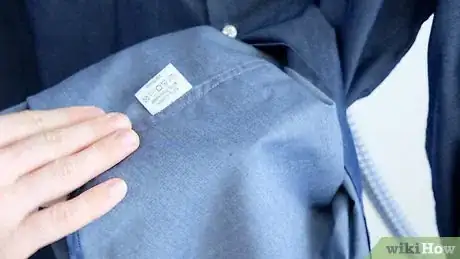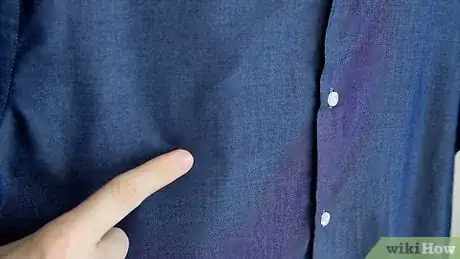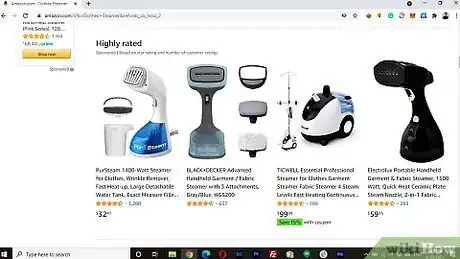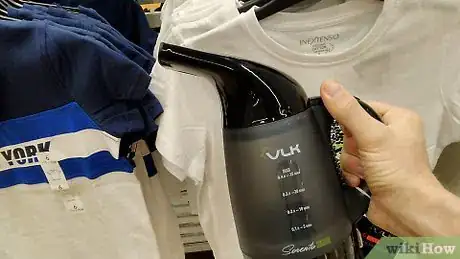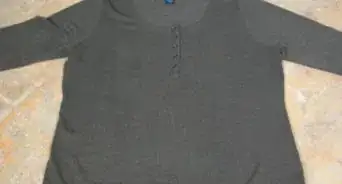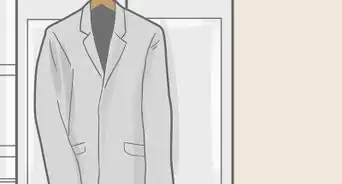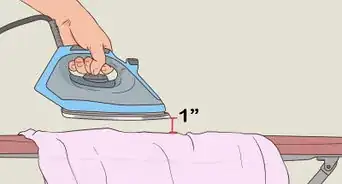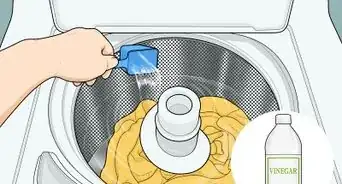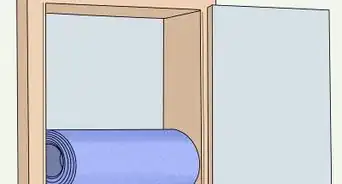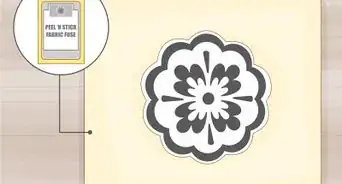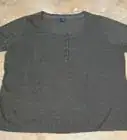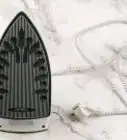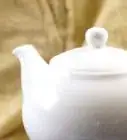This article was co-authored by Susan Stocker. Susan Stocker runs and owns Susan’s Green Cleaning, the #1 Green Cleaning Company in Seattle. She is well known in the region for outstanding customer service protocols — winning the 2017 Better Business Torch Award for Ethics & Integrity —and her energetic support of green cleaning practices.
wikiHow marks an article as reader-approved once it receives enough positive feedback. This article received 12 testimonials and 88% of readers who voted found it helpful, earning it our reader-approved status.
This article has been viewed 424,122 times.
A garment steamer is a great way to remove wrinkles from clothes. Steamers work by heating water until it becomes steam. The steam is then applied to clothing through a nozzle, relaxing the fabric's fibers and eliminating wrinkles. Although they are not as commonly used as traditional irons, clothing steamers are a quick and easy way to get the wrinkles out of many different types of fabrics. After you choose what type of steamer is best for you and learn a few steaming tricks, you'll be steaming your own clothes in no time.
Steps
Knowing When to Use a Steamer
-
1Learn which fabrics can be steamed and which ones cannot. Steamers work wonderfully for most fabrics, as steaming is a delicate method of de-wrinkling. Fabrics that can be steamed include most cottons, silks, wools, and polyesters. However, some fabrics should not be steamed. These fabrics include waxed jackets, suede, or materials that may melt, such as plastic.
- If you’re unsure if your fabric can be steamed, carefully test the steamer on a small corner of the fabric before using it on the entire garment.
- Always check fabric care labels for advice prior to steaming.
-
2Be careful when steaming delicate fabrics. Fabrics made from silk, chiffon, sheer, or velvet should be treated with care. Keep a few inches of distance between the steamer and the fabric, and don't steam in one place of fabric for too long. To avoid damaging embellishments or prints, steam the garment inside out to get rid of the wrinkles.Advertisement
-
3Use a steamer instead of an iron to de-wrinkle a larger variety of clothing. Irons and steamers are both meant to take the wrinkles out of clothing, though they each have their own perks. Irons are typically best on less delicate fabrics (like cotton or denim), and are ideal for pressing creases into clothing. Steamers work on a larger variety of fabrics, as they are less likely to damage fabrics. Steamers are typically used on fabric while it is hanging, so they don't work well if you want to press or crease your clothing.[1]
- Steamers are more portable than irons, so they are ideal for those who travel a lot.[2]
Steaming Your Clothes
-
1Prepare the steamer for use. Pour cold water into the water tank of your clothing steamer. Make sure that all of the parts of the steamer are secured properly, you don't want to leak water all over the place.
- Plug the steamer in. Steamers usually heat up fairly quickly (2-3 minutes). Allow your steamer to heat until steam begins to form. Be sure to let your steamer warm up all of the way to get the best results.
- Make sure it is steaming nicely before you use it. You can check how well it is steaming by pulling the trigger on the handle / pressing the button, and seeing how much steam issues when you release it. This is the same button you will use while steaming your clothes.[3]
-
2Hang the garment you wish to steam. It's easiest to steam a garment when it is hanging. Upright steamers typically have a hanging pole attached. If you're using a handheld steamer, hang your garment on a hanger and place it on a shower rod, the back of a chair, a door knob, or anything of that nature.[4]
-
3Steam your garment by running the steamer in downward strokes along the fabric. You don't need to press hard or push the fabric against anything, the steam will gently remove the wrinkles on its own. As you slide the steamer down your garment, press the steam button every so often to apply steam to the fabric.[5]
- You have the option to use a handheld pad as surface to steam your clothes on, though it is not necessary. It may be helpful when you are steaming extremely dense or wrinkly fabrics. If you decide to use a pad, slip it over one hand and use your other hand to hold the steamer.
- With extremely wrinkly clothing, you should steam from the inside of the garment, or underneath the garment. The weight of the fabric against the steam will help to get the wrinkles out more quickly.
- When steaming fabrics with embellishments such as pleats, ruffles, etc., hold the steamer at a distance of 1-2 inches from the fabric. This will allow the fabric to keep its shape while the steam de-wrinkles it. If the garment is extremely wrinkled, you can also turn the garment inside out to steam the fabric without damaging the embellishments.
-
4Let your garment dry. After a fresh steaming, your garment will feel damp. There may also be some small water spots. Do not be alarmed, this is completely normal and your garment will dry. Let the garment sit for 5-10 minutes after steaming it before you put it on or hang it in your closet. This will give the garment ample time to dry.
Choosing a Steamer
-
1Decide how you will primarily use your steamer. Are you looking for a steamer that will stay in your laundry room, or are you looking for a steamer to carry around with you? Some steamers are easier to transport than others, and some take up more space than others. Some steamers are handheld, others stand upright.[6]
-
2Use an upright steamer. Upright steamer are sometimes referred to as floor steamers, as their base sits on the floor. These steamers typically include a base where the water tank sits, a hose attached to a nozzle, and a pole with a clothing hanger at the top. These steamers typically sit on wheels so that they can be moved more easily.
- If you plan on keeping your steamer in one location, upright steamers are the ideal choice. They are larger than other steamers, but are very convenient because of their features (the clothing hanger, nozzle, etc.). However, they can be transported if you don't mind moving something that's a bit larger.
- These steamers are ideal if you are steaming numerous pieces of clothing. Their water base is large and usually won't need to be refilled.
- Most upright steamers come with attachments, such as different types of brushes for different kinds of fabrics.
- Upright steamers are typically the most expensive of all steamers, ranging from $50-$200.
-
3Use a handheld steamer if you want something more portable. These steamers are much smaller than upright steamers, and can be easily packed in luggage or kept in the car.[7] If you tend to need a steamer while traveling, a handheld steamer would be the ideal choice.
- Handheld steamers combine the water tank and nozzle into one device. They typically weight a couple pounds.
- Some handheld steamers come with attachments, like different nozzles and lint rollers.
- Some steamers come with a small padded square with a strap that slips over your hand (similar to a large oven mitt). This pad can be helpful when you're steaming your clothing, as it can prevent you from burning your hands.
- Handheld steamers typically range in price from $30-$100.[8]
Community Q&A
-
QuestionIs it better to steam a garment as soon as you remove it from the washer or after it is dry?
 Community AnswerThe wet clothes should be allowed to dry first as you do when you are going to iron them. You will have to dry the garment first, before steaming it.
Community AnswerThe wet clothes should be allowed to dry first as you do when you are going to iron them. You will have to dry the garment first, before steaming it. -
QuestionIs the steamer supposed to be used on the garment or just close to it?
 Community AnswerIt depends on the garment that is being steamed. If the garment is delicate, keep your steamer at a distance so that the garment is not ruined. If the garment is heavy or has a lot or wrinkles, place the steamer closer to it or on it.
Community AnswerIt depends on the garment that is being steamed. If the garment is delicate, keep your steamer at a distance so that the garment is not ruined. If the garment is heavy or has a lot or wrinkles, place the steamer closer to it or on it. -
QuestionHow do I hang woman's pants while steaming them?
 Community AnswerYou can get hangers with 2 clips to hang up men's or women's trousers. There is no difference between them as far as the steamer or iron in concerned.
Community AnswerYou can get hangers with 2 clips to hang up men's or women's trousers. There is no difference between them as far as the steamer or iron in concerned.
Warnings
- Steam is extremely hot. Be careful not to put steam on your hands, as you will burn your skin.⧼thumbs_response⧽
References
- ↑ Susan Stocker. Green Cleaning Expert. Expert Interview. 20 April 2020.
- ↑ http://homeguides.sfgate.com/clothes-steamer-vs-iron-92319.html
- ↑ http://www.doityourself.com/stry/how-to-use-a-garment-steamer#b
- ↑ http://www.doityourself.com/stry/how-to-use-a-garment-steamer#b
- ↑ https://www.youtube.com/watch?v=9wcKlDpmfVw
- ↑ http://housewares.about.com/od/sewinglaundry/qt/garmentsteamerusetips.htm
- ↑ Susan Stocker. Green Cleaning Expert. Expert Interview. 20 April 2020.
- ↑ http://www.goodhousekeeping.com/appliances/handheld-steamer-reviews/g1988/best-handheld-steamers/?slide=1
- ↑ Susan Stocker. Green Cleaning Expert. Expert Interview. 20 April 2020.
About This Article
Before you use a clothes steamer, make sure to check the label to determine whether the fabric can be heated. Most fabrics can be steamed, but you shouldn't steam waxed jackets, suede, or fabrics that melt, like plastic. To prepare your steamer, fill the reservoir with cold water and plug it in so that it can heat up. While it is heating, place the garment you want to steam on a hanger. Once the steamer is hot, steam the garment by using downward strokes as you press the steam button. To learn what kind of steamer you should buy and use, read on!
